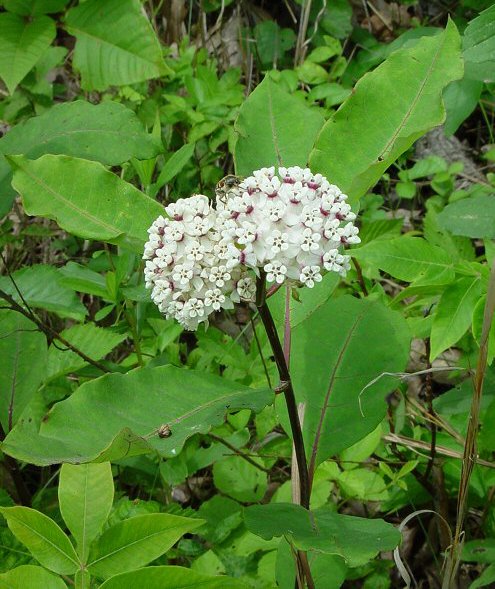Asclepias variegata L.
Variegated Milkweed

Native
CC = 9
CW = 3
MOC = 13
© DETenaglia
Asclepias variegata L.Variegated Milkweed | |
 |
Native CC = 9 CW = 3 MOC = 13 |
© DETenaglia |
|
Family - Asclepiadaceae Habit - Perennial forb with thickened, somewhat tuberous rootstock. Stems - Erect or ascending, to 120 cm, unbranched or occasionally branched once near the tip, usually glabrous below the middle and short-hairy toward the tip, often in longitudinal lines, with milky sap, with 4-7 nodes.
Leaves - Usually opposite, occasionally those at 1 or 2 nodes in whorls of 4, short- to long-petiolate. Leaf blades 2-15 cm long, 1-8 cm wide, mostly ovate to broadly oblong-elliptic, the base tapered, the tip usually pointed, the margins flat or somewhat wavy, less commonly slightly curled under, short-hairy, the upper surface glabrous, the undersurface sparsely short-hairy, mostly along the midvein, somewhat glaucous.
Inflorescence - Terminal and upper axillary umbels, 1-6 per stem, short- to long-stalked, with 18-45 flowers.
Flowers - Calyx lobes 5, reflexed, hairy, 1.5-3.0 mm long, lanceolate to triangular-ovate. Corolla lobes 5, reflexed, glabrous, white, occasionally tinged with pale pink, 7-9 mm long, oblong-elliptic. Gynostegium appearing stalked (the column visible below the bases of the hoods), white with a purple column, the corona conspicuously longer than the tip of the anther/stigma head. Corona hoods white, 2.0-2.5 mm long, spreading to loosely ascending, attached near their bases, broadly obovate in outline to nearly globose, the tips broadly rounded, the margins sometimes with a pair of indistinct, bluntly triangular teeth or lobes at or below the middle, the bases not pouched. Horns white, attached in the basal half of the hoods, bent or curved abruptly inward over the anther/stigma head but not extended past the tips of the hoods, sickle-shaped, stout, somewhat flattened above the middle, the basal half somewhat bulbous-inflated, tapered to a sharp point at the tip.
Fruits - Follicles 10-15 cm long, erect or ascending from mostly erect stalks, narrowly elliptic-lanceolate in outline, the surface smooth, minutely hairy, glaucous. Seeds with the body 5-6 mm long, the margins narrowly to moderately broadly winged, the terminal tuft of hairs white. Flowering - May - July. Habitat - Forest openings, roadsides, disturbed areas, usually in sandy substrate. Origin - Native to the U.S. Lookalikes - None when flowering. A. perennis and A. quadrifolia have white flowers but are much shorter plants with much different leaves. Other info. - This striking species of milkweed can be found in just the extreme southeastern corner of Missouri. Its U.S. range is mainly southeastern, extending from eastern Texas up into New England. The plant is simple to identify in the field because of its big full umbels of white flowers. Like most of the milkweeds, the plant will bleed a thick white sap if injured. This sap can be irritating to some people and is toxic if ingested. Despite this, milkweeds make excellent garden specimens and are simple to grow. The native species take NO care once established. Photographs taken at the Holly Ridge Conservation Area, Stoddard County, MO., 6-14-03, and in the Red Hills of Alabama, 6-4-05 (DETenaglia); also at Holly Ridge Conservation Area, Stoddard County, MO, 5-20-2014 and 5-23-2022 (SRTurner). |